TD Place Stadium
TD Place Stadium (originally Lansdowne Park and formerly Frank Clair Stadium) is an outdoor stadium in Ottawa, Ontario, Canada. It is located at Lansdowne Park, on the southern edge of The Glebe neighbourhood, where Bank Street crosses the Rideau Canal. It is the home of the Ottawa Redblacks of the Canadian Football League (CFL), Atlético Ottawa of the Canadian Premier League (CPL) and the Ottawa Gee-Gees football team of Ontario University Athletics (OUA), which represent the University of Ottawa.
Toronto-Dominion Place Stadium at Landsdowne | |
 | |
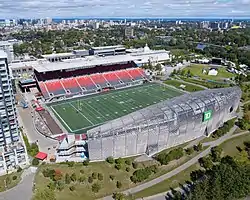 TD Place Stadium in 2022 | |
 TD Place Stadium Location in Ottawa 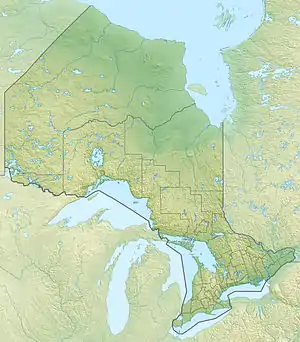 TD Place Stadium Location in Ontario  TD Place Stadium Location in Canada | |
| Former names | Lansdowne Park (1908–1993) Frank Clair Stadium (1993–2014) |
|---|---|
| Address | 1015 Bank Street |
| Location | Ottawa, Ontario |
| Coordinates | 45°23′53.44″N 75°41′1.14″W |
| Public transit | |
| Owner | City of Ottawa |
| Operator | Ottawa Sports and Entertainment Group |
| Capacity | 24,000 |
| Record attendance | 51,242 (92nd Grey Cup) |
| Surface | FieldTurf (2001–present) |
| Opened | 1908 |
| Tenants | |
| Canadian Football Ottawa Rough Riders (CFL) 1908–1996 Ottawa Junior Riders (QJFL) 1997–2006 Ottawa Renegades (CFL) 2002–2005 Ottawa Redblacks (CFL) 2014–present Ottawa Gee-Gees football (OUA) 2022–present Association Football Ottawa Fury FC (NASL/USLC) 2014–2019 Atlético Ottawa (CPL) 2020–present Baseball Ottawa Giants (IL) 1951 Ottawa Athletics (IL) 1952–1954 | |
| Part of a series on |
| Lansdowne Park |
|---|
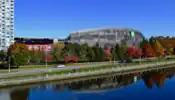 |
| Buildings |
| Sports |
| Other |
|
|
The playing field has existed since the 1870s, and the complete stadium since 1908. The stadium has been host to FIFA tournaments, Summer Olympic Games, and seven Grey Cups.
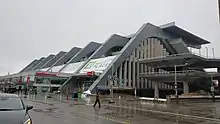
History
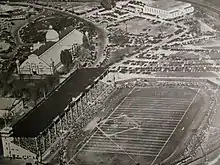
The playing field, part of the Ottawa Exposition Grounds, was first cleared in the 1870s. It was used for equestrian events, lacrosse and rugby football. The first permanent grandstand was built on the north side of the playing field in 1908. It was demolished in 1967 to build a new set of stands with an integrated ice hockey arena underneath, then known as the Ottawa Civic Centre.
A small grandstand was built in the 1920s on the south-side of the field, and it was replaced in 1960. A second deck for the south-side was added during the 1970s. As of 2008, prior to lower south-side demolition, the overall stadium had a 30,927 capacity for football.
In 1984, the grass field which had been in place from 1908 to 1983 was replaced by Astroturf, which lasted though the 2000 season.
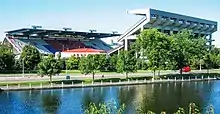
In the late 1990s, the stadium was threatened with demolition when then-city councillor (and future Ottawa mayor) Jim Watson led a drive by the municipal government to allow a private developer to reconfigure Lansdowne Park. The proposals submitted all called for residences to be built on the site of the football stadium. Massive public opposition and the realization that the end of the stadium would mean the end of hopes to return CFL football to the capital led the regional government to step in to end the scheme.
In 2001, one year before the Ottawa Renegades began play, the stadium was the first in the CFL to have a next-generation artificial playing surface (FieldTurf) installed.
For many years, the stadium was known as Lansdowne Park, after the fairgrounds in which it was located. It was renamed in 1993 to honour Frank Clair, coach and general manager for the Ottawa Rough Riders during the 1960s and 1970s.
Revitalization and reconstruction
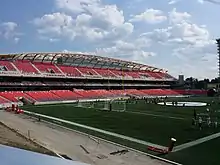
In September 2007, the lower south side stands were closed because of cracks in the concrete structure. After the closure of the stands, then-Ottawa mayor Larry O'Brien was quoted saying that this was an opportunity to do a review of the usage and the facilities of Lansdowne Park.[1] Subsequently, a process was started called "Design Lansdowne" to get public consultations on the Park and the stadium. After an engineering study of the north-side and south-side grandstands, the south-side stands were condemned. The lower section of the stands was demolished by controlled implosion on July 20, 2008 at 8:03 am.
During the summer of 2008, a consortium of investors was formed to pursue a new CFL team in Ottawa. They bid successfully and received a conditional franchise from the CFL, with the condition that the stadium would need to be upgraded before the franchise could be activated. Jeff Hunt, one of the principal investors and owner of the Ottawa 67's who play in the attached arena, stated that the venue and location are ideal, with over a million people in Ottawa. The organization had reportedly already pre-sold 5,000 season tickets.
In the fall of 2008, the consortium, known as Ottawa Sports and Entertainment Group (OSEG), approached the City with a plan to redevelop Lansdowne Park and rebuild the stadium using the proceeds from turning a section of the park into commercial and retail space. The plan, entitled Lansdowne Live! was ambitious and included plans to redevelop all sections of the park. The City, which had received a competing stadium proposal located in Kanata, reviewed the plans and agreed to a conditional agreement with OSEG. OSEG would concentrate on the stadium and commercial/residential precinct, and Ottawa would return the rest of Lansdowne Park to green space. Faced with opposition to the plan, the City proceeded slowly with the proposal, seeking out legal opinions, traffic studies, and an urban park design competition for Lansdowne.
In June 2010 it was announced that Ottawa City Council had approved a redevelopment plan put forward by OSEG to renovate Frank Clair Stadium and build 350,000 sq ft (33,000 m2) of commercial retail space, 250 housing units and an urban park on the site. The stadium, which was the catalyst to bring the CFL back to Ottawa is to be rent-free to developers for 30 years. Proceeds from the retail and commercial precinct would be shared, and the retail and commercial precinct brought under City control after 30 years. Completion of the overall development was scheduled for 2015.
The OSEG proposal for the stadium envisioned tearing down all of the south-side stands, replacing the stands with a new structure with private boxes and a unique wood-wrapping around the exterior. The north-side stands were to be renovated to current standards, and the north-side exterior expanded to include a retail component. In September 2010, the management group of what would become Ottawa Fury FC joined the plan to redevelop Lansdowne. On June 20, 2011, Ottawa was awarded a professional soccer franchise in the North American Soccer League (NASL) to start play in 2014.[2]
In November 2011, demolition of the rest of the south side stands started. The contract to demolish the stands was awarded for $550,000. Unlike the lower stands, the upper stands structure was demolished piece-by-piece rather than controlled implosion.[3] The concrete and steel from the structure was recycled, and the seats re-used at a new skating and hockey rink at Ottawa City Hall. Demolition was completed by January 2012.[4]
On January 7, 2014, Frank Clair Stadium and the Civic Centre Arena were renamed TD Place under a new sponsorship deal with the Toronto-Dominion Bank.[5][6]
The stadium was completed for the first Ottawa Redblacks home game on July 18, 2014. The Ottawa Fury opened their fall season on the same weekend after playing their previous home games that year at Keith Harris Stadium at Carleton University.
On October 29, 2014, the press box and media centre at the stadium were named for Ernie Calcutt, a former broadcaster for the Ottawa Rough Riders.[7][8]
Tenants
The Ottawa Rough Riders football team and its predecessors played at the field from their inception in 1876 until 1996, when the team ceased operations. A successor team, the Ottawa Renegades, played at the stadium from 2002 until 2005. Ottawa's third CFL team, the Redblacks, have played at the stadium since 2014.
From the 1870s onward, the field was also home to University of Ottawa's Gee-Gees football team. The stadium is home to the Panda Game, an annual game between the cross-city rivals, the Carleton University Ravens and the Gee-Gees. At the Panda Game in 1987, the game was marred by an accident when at least 25 students were injured when a section of railing collapsed and the result was forfeited.
The stadium has also been home to the Ottawa Junior Riders of the Quebec Junior Football League and the Ottawa Bootleggers of the Empire Football League.
The field was also the home of minor-league baseball. The stadium was the home venue of the Ottawa Giants and Ottawa Athletics minor-league baseball teams.
Ottawa Fury FC were the first professional soccer club to play in the renovated TD Place Stadium, playing from the start of the 2014 fall season of the North American Soccer League until the end of the 2019 fall season of the USL Championship. The top-tier Canadian professional club Atlético Ottawa joined the Canadian Premier League in the 2020 season.
Major events
Football
The stadium has played host to seven Grey Cup games, the first occasion being in 1925 when Ottawa won its first Grey Cup title. It later held Grey Cup games in 1939, 1967, 1988, and 2004. On July 31, 2016, the CFL awarded Ottawa the 105th Grey Cup game, to be played at TD Place Stadium in 2017, as part of celebrations to mark 150 years of Confederation.[9] The 55th Grey Cup in 1967 was similarly played at Lansdowne Park as part of celebrations to mark the Centennial of Confederation.
The stadium has hosted the Panda Game, a Canadian rivalry football game between the two OUA football teams in Ottawa, the University of Ottawa Gee-Gees and Carleton University Ravens, in the years the game has been played while the facility has had a CFL tenant. This is one of the oldest and richest rivalries in Canadian university football, and currently the most attended Canadian university football game. Because these universities are not beneficiaries of the naming rights agreement with the bank, some sources prefer to use the name "Lansdowne Park" for the Panda Game venue, although unlike for international soccer (see below) this is not official policy.
Soccer
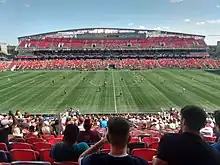
During the 1976 Summer Olympics in Montreal, the stadium hosted five soccer matches.[10][11]
In mid-2007, the stadium was one of six hosts in the 2007 FIFA U-20 World Cup. Capacity was then listed at 28,826.
In 2014, Ottawa Fury FC joined the North American Soccer League (NASL) and made an agreement to use the stadium as its home grounds.[12]
The stadium was one of six chosen to host matches for the 2015 FIFA Women's World Cup; it hosted a total of six group stage matches, two Round of 16 matches, and one quarter-final match. Due to FIFA policy forbidding commercial sponsorship of stadium names, the stadium was known as "Lansdowne Stadium"[13] during the tournament.
A portion of FieldTurf and some field-level stands set up for soccer matches suffered minor fire damage on July 18, 2018, during the Fury FC home leg of the 2018 Canadian Championship semifinal against Toronto FC. The cause was lit flares brought in by some members of a Toronto supporters' group, the "Inebriatti", which ignited one of their banners.[14][15][16] Also, at least one firework was detonated during the incident.[17]
In 2019, Ottawa Fury ceased operations after it lost its sanctioning to play in the USL Championship and refused to join the Canadian Premier League (CPL). In 2020, Atlético Ottawa joined the Canadian Premier League representing Ottawa, using TD Place Stadium as its home grounds.[18]
Hockey
On March 17, 2017, the National Hockey League announced that it would hold an outdoor game at TD Place Stadium between the Ottawa Senators and Montreal Canadiens on December 16, 2017 to mark the 100th anniversary of their inaugural NHL game.[19][20] Due to sponsorship issues (Scotiabank, a competitor in Canadian banking, was the title sponsor of the game itself), the venue was known as "Lansdowne Stadium" for the game.
| Date | Away team | Result | Home team | Spectators |
|---|---|---|---|---|
| December 16, 2017 | Montreal Canadiens | 0–3 | Ottawa Senators | 33,959 |
| December 17, 2017 | Gatineau Olympiques | 4–1 | Ottawa 67's | 11,671 |
Concerts
| Date | Artist(s) | Opening act(s) | Tour | Tickets sold | Revenue | Additional notes |
|---|---|---|---|---|---|---|
| August 28, 1987 | David Bowie | Duran Duran Eight Seconds The Northern Pikes | Glass Spider Tour | 29,000 | — | This concert drew the largest crowd for an Ottawa concert ever at the time.[21] |
| September 9, 1987 | Pink Floyd | — | A Momentary Lapse of Reason Tour | 26,062 / 35,000 | $495,099 | |
| August 5, 1990 | New Kids on the Block | — | The Magic Summer Tour | 30,000 / 30,000 | — | |
| August 14, 1998 | Various Artists | Lilith Fair | — | — | ||
| August 28, 2005 | The Rolling Stones | Les Trois Accords Our Lady Peace | A Bigger Bang | 43,000 | — | |
| September 3, 2015 | AC/DC | Vintage Trouble | Rock or Bust World Tour | 32,000 / 32,000 | — | The first major concert event at the renovated TD Place Stadium.[22] |
| August 21, 2017 | Guns N' Roses | Our Lady Peace | Not in This Lifetime... Tour | 21,204 / 25,714 | $2,144,550 | [23] |
Gallery
 The now-demolished south side stands during a soccer game
The now-demolished south side stands during a soccer game TD Place Stadium viewed from across the Rideau Canal in 2014
TD Place Stadium viewed from across the Rideau Canal in 2014 TD Place Stadium at night in September 2021
TD Place Stadium at night in September 2021 North stand
North stand South stand
South stand Field
Field
See also
References and notes
- "Ottawa closes stadium section due to cracks in structure". CBC News. September 6, 2007. Retrieved January 10, 2008.
- "NASL". Ottawafury.com. Archived from the original on March 15, 2012. Retrieved April 7, 2012.
- "Tear-down of Frank Clair's south stands begins". CTV News. November 4, 2011. Retrieved November 7, 2011.
- Miller, Robyn (November 4, 2011). "Demolition begins at Lansdowne Park". 1310 News. Archived from the original on February 9, 2012. Retrieved November 7, 2011.
- "Lansdowne stadium, arena, to be renamed TD Place". January 7, 2014.
- "Frank Clair Stadium, Civic Centre to become TD Place". January 7, 2014.
- Holder, Gord (October 30, 2014). "Ex-Riders broadcaster Ernie Calcutt honoured at rebuilt stadium". Ottawa Citizen. Ottawa, Ontario.
- "Le Rouge et Noir rend hommage à Ernie Calcutt". Le Droit (in French). Ottawa, Ontario. October 30, 2014.
- "Ottawa to host 105th Grey Cup in 2017". Canadian Football League. July 31, 2016. Retrieved July 31, 2016.
- 1976 Summer Olympics official report. Volume 2. pp. 230–3.
- 1976 Summer Olympics official report. Volume 3. pp. 279–87.
- Hofley, Chris (July 21, 2014). "NY Cosmos down Ottawa Fury FC 1–0". Ottawa Sun. Retrieved July 4, 2018.
- "FIFA Women's World Cup Canada 2015™ Destination: Ottawa". FIFA. Archived from the original on May 12, 2012. Retrieved January 4, 2015.
- Campbell, Don (July 18, 2018). "Fury can't solve Toronto FC in violent opening leg of Canadian Championship semifinal". Ottawa Sun. Retrieved July 19, 2018.
- Delamont, Kieran (July 18, 2018). "Flare starts a fire that held up Wednesday's Ottawa Fury game". Ottawa Citizen. Retrieved July 19, 2018.
- "TFC terminates Inebriatti's supporters group status". sportsnet.ca. August 23, 2018. Retrieved March 16, 2019.
- Ferreras, Jesse (July 18, 2018). "Toronto FC soccer fan group triggers blast, ignites fire in the stands at Ottawa Fury game". Global Toronto. Retrieved July 19, 2018.
- "Pro soccer returning to Ottawa this spring". CBC. January 29, 2020.
- "Senators to host Canadiens in outdoor NHL game Dec. 16 at TD Place". CBC News Ottawa. Retrieved March 18, 2017.
- "Senators Dec. 16 outdoor game against Canadiens caps off big anniversary year". Ottawa Citizen. Postmedia Network. Retrieved March 18, 2017.
- Barr, Greg (January 11, 2016). "1987: David Bowie breaks attendance record for Ottawa rock shows". Retrieved January 11, 2016.
- Simpson, Peter (September 4, 2015). "Review: AC/DC christens TD Place with a whole lotta rock". Ottawa Citizen. Retrieved September 4, 2015.
- "Our Lady Peace to join Guns N' Roses on select Canadian dates - Sound Check Entertainment". May 25, 2017. Retrieved November 20, 2017.

